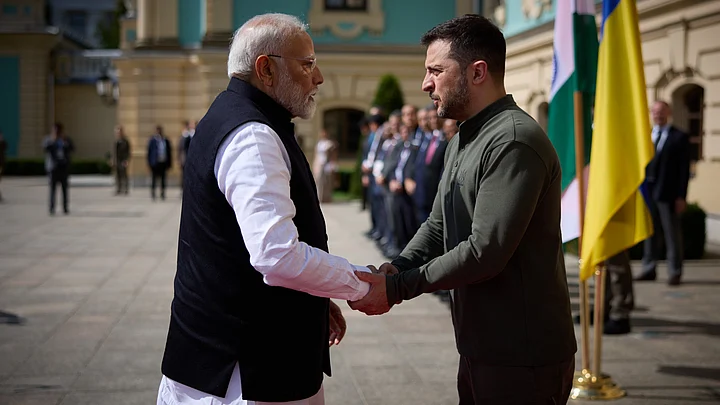Besides asking tough questions about India’s proximity and friendship towards Russia, Ukrainian President Volodymyr Zelenskyy displayed perplexity about why Prime Minister Narendra Modi was in Kyiv in the first place. Even after the seven-hour visit to Kyiv after a 10-hour train ride from Poland, the real import of this journey remains wrapped in mystery.
If the trip was about brokering peace, Ukraine did not buy India's services. Instead, it chose the UAE to organise a prisoner swap between the warring nations. And if the purpose was to organise a ceasefire after the Kursk occupation by Ukraine and work towards a land swap, then the fierce attack by Russia on Monday conveyed the message that both belligerents are in no mood to back off.
Then why did PM Modi travel to Kyiv?
Quite visibly, he was forced to visit the Ukrainian capital after his earlier trip to Moscow where he famously embraced Russian President Vladimir Putin. His bear hug was juxtaposed with Russia allegedly bombing Ukraine’s biggest children's hospital, an attack that killed 38 people. The Russians denied having any role, but who's believing them? Instead, questions were asked even by President Zelenskyy, who claimed that Putin had no respect for Modi as he bombed Ukraine even when he was visiting Moscow.
Though the Indian prime minister had expressed sadness over the death of children and how "this is not the era of war," his presence in Moscow last month did not augur well for his credibility as a potential peacemaker. Similarly, his presence in Kyiv may not have endeared him to Russia and Putin. Russia would not have liked how India sat down with a close ally of the US and NATO that wants nothing more than the dismantling of Vladimir Putin.
It seems that Modi, recovering from his electoral setback while heading a coalition government in Delhi, credible sources claim, was sold the idea by the US or a similar Western entity, that he could be the peacemaker that the world awaits, as he has had close ties with the Putin.
Bizarrely, two days after his visit, PM Modi made a phone call to US President Joe Biden informing him about his visit to Kyiv and his desire for peace. While the Indian readout of the call included the issue of protecting Bangladeshi Hindus besides his concern for Ukraine, the US spoke only of Modi’s courageous visit to Kyiv.
In fact, it gave an opportunity to Republican Senator Niraj Antani to tweet, "Very disappointing that the @WhiteHouse’s readout of the @JoeBiden-@narendramodi call doesn’t acknowledge the plight of Bangladeshi Hindus, as the Indian Prime Minister’s readout does. Shameful. The Biden administration’s callous indifference of Bangladeshi Hindus is abhorrent."
It’s a different matter that Zelenskyy was undiplomatically castigating India for buying oil from Russia and providing Putin with a war chest. While Zelenskyy’s reservations were well known, Modi still chose to travel to Ukraine after its Kursk incursion. Russia has now recovered with an aggressive fusillade of missile attacks. At the time of writing, the exchange of fire has intensified. Zelenskyy’s Independence Day speech that promised war in Russia may have acquired a different spin altogether.
The US and NATO are aware that they cannot subdue Russia till two of its allies, China and India, stop supporting it. The US has been working on China to fall in line. In March, legislation was unveiled that would block China from buying oil from the Strategic Petroleum Reserve.
Similarly, US think tanks gloatingly explain how India's dependence on Russian weapons has gone down considerably. Till 2013, India was buying 76 percent of its arms from Russia. This has now come down to 36 percent. India is also under pressure to taper its purchase of offshore crude oil from Russia as the global supply stabilises.
US experts have been telling India that there is no reason why it should buy any weapon from the Russians. The US has offered to set up a Kalashnikov factory in India, which they hope to bring from a former Soviet Republic. Kalashnikovs were a Russian monopoly, but after the collapse of the Soviet Union, it is available, in bulk, in other breakaway Soviet Republics of Eastern Europe and Central Asia.
While Modi was in Ukraine, Defence Minister Rajnath Singh was in the US, meeting the heads of many arms manufacturers. There is, after all, the US-India Roadmap for Defence Industrial Cooperation. Rajnath reportedly bought snoopers to locate the presence of a submarine in Indian waters. Much of the equipment that India bought or seemed to be interested in had a visible China focus.
The manner in which the US is pressuring India, and to some extent China, has important implications for BRICS too, a multilateral body that is at the forefront of de-dollarising the world economy. India has been ambivalent about de-dollarisation and taking on the US. It had not attended the Shanghai Cooperation Summit at Astana earlier in June, which was piloted by Russia and China.
The next BRICS summit will take place in October in Kazan, Russia. 70 odd countries are keen to join the evolving multilateral body, much to the annoyance of the US and its NATO allies.
(The author is the editor of Delhi's Hardnews magazine. This is an opinion piece and the views expressed above are the author’s own. The Quint neither endorses nor is responsible for them.)
(At The Quint, we question everything. Play an active role in shaping our journalism by becoming a member today.)
